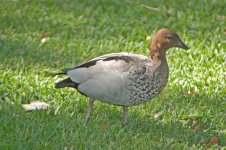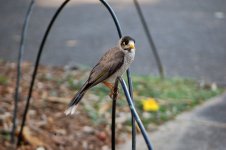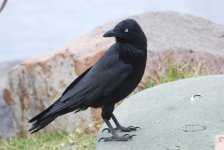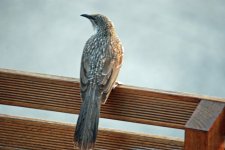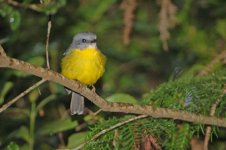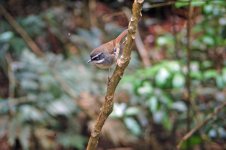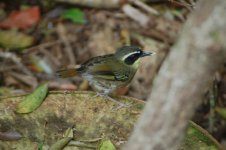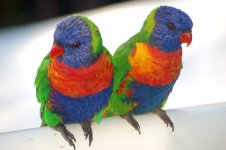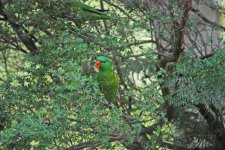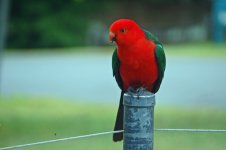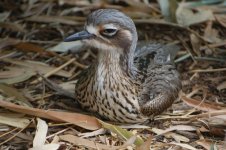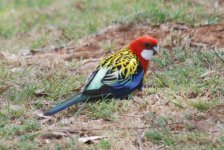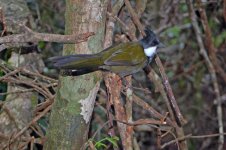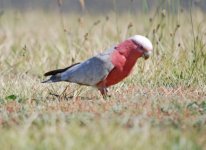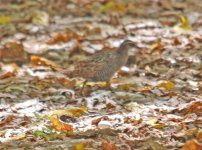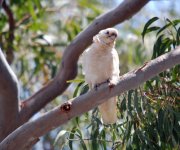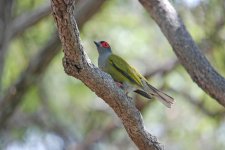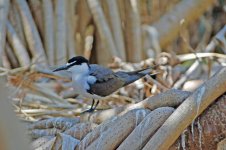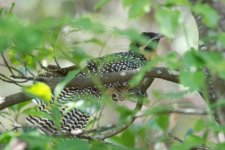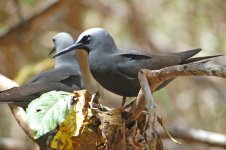First a bit of a preamble: I am not a novice when I’m in the UK but this was my first Australian trip, apart from a few days in Sydney 5 years ago. I tend to bird watch on holiday rather than go on bird watching holidays.
While in Australia, I used the Slater Field Guide to Australian Birds and the Michael Morcombe app. Neither is ideal, the Slater having irritating indexing errors and the Morcombe having no photos and a restricted search function. Nevertheless, I reckon I did well to see 130+ species of birds in three and a half weeks without too much expert help.
Starting off with a few days more in Sydney from 5 October, we did more or less the same things as before and unsurprisingly saw more or less the same birds as 5 years ago. My husband is very keen on boats and so we spent a lot of time in the harbour area, arriving on the back of an International Fleet Review.
The Botanical Gardens, which hosts common birds such as Sulphur Crested Cockatoo, White Ibis, Masked Lapwing, Rainbow Lorikeet, Australian Wood Duck, Noisy Miner, Welcome Swallow, Magpie-lark and Eastern Rosella is luckily right on the water’s edge. Both parties were therefore happy. Five years ago the Gardens were home to a huge number of fruit bats. These have apparently been encouraged to go elsewhere with the help of heavy metal music.
On next for a few days in the Blue Mountains, soon to be devastated (after we left) by bushfires. We stayed at Katoomba and got an excellent free leaflet about bird watching sites in the area from the Visitor Information Centre at Echo Point.
The Capertee Valley is highly recommended as a top Australian birdwatching site. However, we saw disappointingly few birds and a conversation with someone doing a bird survey confirmed that it had been a poor migration year. Suggestions were that the unseasonally hot weather and very low rainfall were perhaps to blame for migrants arriving late or not at all. Those that did arrive to nest must have been devastated by the fires.
One of our favourite places in the Blue Mountains was at Megalong, a picnic and camping area by a very pleasant small river. Here I saw my first Laughing Kookaburra. This became a surprisingly common bird throughout the holiday. Others seen that became common were Willie Wagtail, Jacky Winter, Crimson Rosella, Galah and Noisy Friarbird. We also got views of White throated Gerygone, Golden Whister, Leaden Flycatcher and Bassian Thrush.
After the Blue Mountains, we headed north, arriving next at Hawk’s Nest, a small town in the Myall Lakes area. Another beautiful spot, but disappointing in terms of waders as it is a Ramsar site. Maybe it was the wrong time of year.
We saw a good selection of Honeyeaters, a group of birds that I had never seen before: Lewin’s, White-naped, Yellow-faced, Blue-faced. As we drove past a golf course, a flock of Scaly breasted Lorikeets came down and started feasting on fruit in a bush. Other common birds in the area were Pelican, Little Wattlebird and Crested Pigeon. I was also delighted to see a pair of Superb Fair Wrens, who were obviously nesting around some sand dunes. They seem to crop up in a variety of habitats.
Stopping for a view by a river, two birds with very long tail streamers passed overhead. On checking the book, these proved to be White-tailed Tropicbirds. The book says that these sometimes come inshore in stormy weather. That night we had a huge thunderstorm which went on for hours and put out the fires that we could see burning across the river in Post Stephens. I guess the book was right and they were taking shelter from the storm.
14 October and we were travelling on to Coff’s Harbour. Stopping for lunch at a very windswept Nambucca Heads, we saw Pied Oystercatcher, Eastern Curlew and Great Egret. I suspect that a less windy day might have brought more waders on to the beach.
The main attraction at Coff’s from a birdwatching point of view is Muttonbird Island. You can walk onto this quite easily from the town. This is full of Wedge-tailed Shearwater burrows. They were flying and fishing quite close to the shore. Around January time, the chicks would be visible. There were whales visible from the shore and there was a White-faced Heron plus two Sooty Oystercatchers on the rocks.
The Botanic Gardens at Coff’s, which incorporates part of the river, is also well worth a visit. We saw Hardhead, Brown Quail, Pacific Black Duck, Darter, Intermediate Egret, Azure Kingfisher and Little Pied Cormorant. A walk behind the main beach revealed Red browed Finch, Eastern Whipbird and White-browed Scrubwren amongst the shrubbery.
Dorrigo National Park can be visited on a day trip from Coff’s. New birds seen in and around here included Straw-necked Ibis, White necked Heron, White-eared Monarch, Eastern Yellow Robin and Rufous Fantail. This latter tiny bird had apparently migrated a staggering 10,000 km from New Guinea. There is a good visitor centre at Dorrigo and a short tree-top skywalk.
Then on to the world-famous O’Reilly’s Rainforest Retreat in the Green Mountains section of Lamington National Park. Often described as a birdwatchers paradise, it is, but also much loved by weekenders from Brisbane and people who come for camping, luxury spas and walking. It was very busy. I shouldn’t be snotty but enough to say that the early morning bird walks attracted a lot of non-birdwatchers.
The birds at O’Reilly’s are very used to people as they are fed and therefore photo opportunities are excellent. Regent and Satin Bowerbird, King Parrot, Eastern Whipbird, Logrunner, White-browed and Yellow-throated Scrubwren, Eastern Spinebill, Grey Shrike Thrush, Brown Gerygone, Diamond Firetail, Brown Thornbill and Wonga Pigeon are all easily seen, either from the boardwalk or around the feeding area.
On walks of our own, we got glimpses of very vocal Green Catbirds, saw Brown Cuckoo-Doves and a pair of Grey Goshawks. Very disappointed not to see a Lyrebird despite looking very hard.
20 October saw as reach Brisbane, where we spent a couple of nights. We headed for the riverfront and parklands on the south bank. The Botanic Gardens are close by. This area has now more or less recovered from the devastating floods of a couple of years ago. Plenty of birds, but not many of them were new. The exception was a group of three Bush Stone Curlews sitting under some bushes in the Botanic Gardens. I thought this was a very unlikely habit for such a bird, but apparently not so. They were very approachable though hissed quite a lot when I got near.
Heading further north into Queensland, we were on our way to Agnes Water and the Town of 1770. The Bruce Highway is an interminable stretch with stop-go road works. I’m told this stretches all the way up to Cairns and has added up to 7 hours to the journey.
We started to see more raptors, which included a group of Black Kites feeding at a rubbish dump, Brown Falcon and Square-tailed Kite.
Town of 1770 is the departure point for the southern Great Barrier Reef and Lady Musgrave Island. The whole area is very beautiful. The trip out to the Island is 64 km. Unfortunately the catamaran was running head-on into the waves. Just managed to hold on to the contents of my stomach for the nearly 2 hour crossing but it was a close thing and many didn’t.
The set up on this trip is that you spend part of the time swimming/snorkelling from a pontoon, part of the time in a glass-bottomed boat and about 40 minutes on Lady Musgrave Island itself. Birds seen either from the catamaran or the pontoon included a Great Frigatebird, several Brown Boobies, Crested Terns and many Wedge-tailed Shearwaters .
Lady Musgrave Island itself is colonised by Black Noddies and I don’t believe I have ever seen such a great concentration of one species of bird in one place. Bridled Terns also shared their breeding space. There was a Buff-banded Rail wandering about and an Eastern Reef Egret on the rocks. On the beach there were Black-naped Terns, Little Terns, Pied Oystercatchers, Bar-tailed Godwits, Lesser Sand-plovers, Whimbrels, a Ruddy Turnstone and a Wandering Tattler.
The return voyage was much kinder and I fell asleep as flying fish played along side. Back at 1770, the tide had gone out, the boat couldn’t get past the sandbar and we had to be taken ashore in a dodgy launch.
The next day was my birthday, which we spent looking around Agnes Water. Just driving around a housing estate, we became aware of dozens of Rainbow Bee-eaters and had our first really good look at Kangaroos.
This was as far north as we got. Cairns and the Daintree will have to wait for another trip. However, birdwatching wasn’t done and we headed down to Noosa, another beautiful spot with lots of waterways in the area.
We liked this town very much. It astonishes me how many amazing birds are right there in front of you: a Yellow-tailed Black Cockatoo just sitting in a tree in a busy street for example. We had a short walk into the National Park attached to the town. It was very hot, so we headed for the cooler boardwalk area which runs down into the town.
A great commotion of little birds in the bushes was the result of a female Eastern Koel trying to get into their nests. A passer-by told us that she had been walking that route for 10 years and had never seen one before. We walked back the same way 10 minutes later. It had disappeared but we saw Figbirds, a Variegated Fairy Wren and Little Corella instead. A White bellied Sea Eagle flew parallel to us.
On returning to our accommodation, I sustained a first-ever bird related injury as a Brush Turkey decided that it wanted to get into our room and gave me a bite on the big toe!
27 October and the last full day of our holiday. We took a boat trip into what they call the Everglades. Another interesting boating experience as you have to go across a large lake which is only a few inches deep. We grounded there and back, had to keep moving to balance the boat and it was touch and go whether we would have to get out and push.
According to the skipper, it was an unusually quiet bird day. However, we saw a White bellied Sea Eagle in aerial combat with two Whistling Kites, my husband saw a Glossy Black Cockatoo, there were Azure Kingfishers, Little Pied Cormorants and a Bar-shouldered Dove.
On our way back to catch the plane at Brisbane, we stopped at Mooloolaba and Caloundra and saw Brahminy and Wedge-tailed Kites.
Over 130 species of birds seen, nearly 100 of them new to me and very little expert help. Not bad for a novice!
While in Australia, I used the Slater Field Guide to Australian Birds and the Michael Morcombe app. Neither is ideal, the Slater having irritating indexing errors and the Morcombe having no photos and a restricted search function. Nevertheless, I reckon I did well to see 130+ species of birds in three and a half weeks without too much expert help.
Starting off with a few days more in Sydney from 5 October, we did more or less the same things as before and unsurprisingly saw more or less the same birds as 5 years ago. My husband is very keen on boats and so we spent a lot of time in the harbour area, arriving on the back of an International Fleet Review.
The Botanical Gardens, which hosts common birds such as Sulphur Crested Cockatoo, White Ibis, Masked Lapwing, Rainbow Lorikeet, Australian Wood Duck, Noisy Miner, Welcome Swallow, Magpie-lark and Eastern Rosella is luckily right on the water’s edge. Both parties were therefore happy. Five years ago the Gardens were home to a huge number of fruit bats. These have apparently been encouraged to go elsewhere with the help of heavy metal music.
On next for a few days in the Blue Mountains, soon to be devastated (after we left) by bushfires. We stayed at Katoomba and got an excellent free leaflet about bird watching sites in the area from the Visitor Information Centre at Echo Point.
The Capertee Valley is highly recommended as a top Australian birdwatching site. However, we saw disappointingly few birds and a conversation with someone doing a bird survey confirmed that it had been a poor migration year. Suggestions were that the unseasonally hot weather and very low rainfall were perhaps to blame for migrants arriving late or not at all. Those that did arrive to nest must have been devastated by the fires.
One of our favourite places in the Blue Mountains was at Megalong, a picnic and camping area by a very pleasant small river. Here I saw my first Laughing Kookaburra. This became a surprisingly common bird throughout the holiday. Others seen that became common were Willie Wagtail, Jacky Winter, Crimson Rosella, Galah and Noisy Friarbird. We also got views of White throated Gerygone, Golden Whister, Leaden Flycatcher and Bassian Thrush.
After the Blue Mountains, we headed north, arriving next at Hawk’s Nest, a small town in the Myall Lakes area. Another beautiful spot, but disappointing in terms of waders as it is a Ramsar site. Maybe it was the wrong time of year.
We saw a good selection of Honeyeaters, a group of birds that I had never seen before: Lewin’s, White-naped, Yellow-faced, Blue-faced. As we drove past a golf course, a flock of Scaly breasted Lorikeets came down and started feasting on fruit in a bush. Other common birds in the area were Pelican, Little Wattlebird and Crested Pigeon. I was also delighted to see a pair of Superb Fair Wrens, who were obviously nesting around some sand dunes. They seem to crop up in a variety of habitats.
Stopping for a view by a river, two birds with very long tail streamers passed overhead. On checking the book, these proved to be White-tailed Tropicbirds. The book says that these sometimes come inshore in stormy weather. That night we had a huge thunderstorm which went on for hours and put out the fires that we could see burning across the river in Post Stephens. I guess the book was right and they were taking shelter from the storm.
14 October and we were travelling on to Coff’s Harbour. Stopping for lunch at a very windswept Nambucca Heads, we saw Pied Oystercatcher, Eastern Curlew and Great Egret. I suspect that a less windy day might have brought more waders on to the beach.
The main attraction at Coff’s from a birdwatching point of view is Muttonbird Island. You can walk onto this quite easily from the town. This is full of Wedge-tailed Shearwater burrows. They were flying and fishing quite close to the shore. Around January time, the chicks would be visible. There were whales visible from the shore and there was a White-faced Heron plus two Sooty Oystercatchers on the rocks.
The Botanic Gardens at Coff’s, which incorporates part of the river, is also well worth a visit. We saw Hardhead, Brown Quail, Pacific Black Duck, Darter, Intermediate Egret, Azure Kingfisher and Little Pied Cormorant. A walk behind the main beach revealed Red browed Finch, Eastern Whipbird and White-browed Scrubwren amongst the shrubbery.
Dorrigo National Park can be visited on a day trip from Coff’s. New birds seen in and around here included Straw-necked Ibis, White necked Heron, White-eared Monarch, Eastern Yellow Robin and Rufous Fantail. This latter tiny bird had apparently migrated a staggering 10,000 km from New Guinea. There is a good visitor centre at Dorrigo and a short tree-top skywalk.
Then on to the world-famous O’Reilly’s Rainforest Retreat in the Green Mountains section of Lamington National Park. Often described as a birdwatchers paradise, it is, but also much loved by weekenders from Brisbane and people who come for camping, luxury spas and walking. It was very busy. I shouldn’t be snotty but enough to say that the early morning bird walks attracted a lot of non-birdwatchers.
The birds at O’Reilly’s are very used to people as they are fed and therefore photo opportunities are excellent. Regent and Satin Bowerbird, King Parrot, Eastern Whipbird, Logrunner, White-browed and Yellow-throated Scrubwren, Eastern Spinebill, Grey Shrike Thrush, Brown Gerygone, Diamond Firetail, Brown Thornbill and Wonga Pigeon are all easily seen, either from the boardwalk or around the feeding area.
On walks of our own, we got glimpses of very vocal Green Catbirds, saw Brown Cuckoo-Doves and a pair of Grey Goshawks. Very disappointed not to see a Lyrebird despite looking very hard.
20 October saw as reach Brisbane, where we spent a couple of nights. We headed for the riverfront and parklands on the south bank. The Botanic Gardens are close by. This area has now more or less recovered from the devastating floods of a couple of years ago. Plenty of birds, but not many of them were new. The exception was a group of three Bush Stone Curlews sitting under some bushes in the Botanic Gardens. I thought this was a very unlikely habit for such a bird, but apparently not so. They were very approachable though hissed quite a lot when I got near.
Heading further north into Queensland, we were on our way to Agnes Water and the Town of 1770. The Bruce Highway is an interminable stretch with stop-go road works. I’m told this stretches all the way up to Cairns and has added up to 7 hours to the journey.
We started to see more raptors, which included a group of Black Kites feeding at a rubbish dump, Brown Falcon and Square-tailed Kite.
Town of 1770 is the departure point for the southern Great Barrier Reef and Lady Musgrave Island. The whole area is very beautiful. The trip out to the Island is 64 km. Unfortunately the catamaran was running head-on into the waves. Just managed to hold on to the contents of my stomach for the nearly 2 hour crossing but it was a close thing and many didn’t.
The set up on this trip is that you spend part of the time swimming/snorkelling from a pontoon, part of the time in a glass-bottomed boat and about 40 minutes on Lady Musgrave Island itself. Birds seen either from the catamaran or the pontoon included a Great Frigatebird, several Brown Boobies, Crested Terns and many Wedge-tailed Shearwaters .
Lady Musgrave Island itself is colonised by Black Noddies and I don’t believe I have ever seen such a great concentration of one species of bird in one place. Bridled Terns also shared their breeding space. There was a Buff-banded Rail wandering about and an Eastern Reef Egret on the rocks. On the beach there were Black-naped Terns, Little Terns, Pied Oystercatchers, Bar-tailed Godwits, Lesser Sand-plovers, Whimbrels, a Ruddy Turnstone and a Wandering Tattler.
The return voyage was much kinder and I fell asleep as flying fish played along side. Back at 1770, the tide had gone out, the boat couldn’t get past the sandbar and we had to be taken ashore in a dodgy launch.
The next day was my birthday, which we spent looking around Agnes Water. Just driving around a housing estate, we became aware of dozens of Rainbow Bee-eaters and had our first really good look at Kangaroos.
This was as far north as we got. Cairns and the Daintree will have to wait for another trip. However, birdwatching wasn’t done and we headed down to Noosa, another beautiful spot with lots of waterways in the area.
We liked this town very much. It astonishes me how many amazing birds are right there in front of you: a Yellow-tailed Black Cockatoo just sitting in a tree in a busy street for example. We had a short walk into the National Park attached to the town. It was very hot, so we headed for the cooler boardwalk area which runs down into the town.
A great commotion of little birds in the bushes was the result of a female Eastern Koel trying to get into their nests. A passer-by told us that she had been walking that route for 10 years and had never seen one before. We walked back the same way 10 minutes later. It had disappeared but we saw Figbirds, a Variegated Fairy Wren and Little Corella instead. A White bellied Sea Eagle flew parallel to us.
On returning to our accommodation, I sustained a first-ever bird related injury as a Brush Turkey decided that it wanted to get into our room and gave me a bite on the big toe!
27 October and the last full day of our holiday. We took a boat trip into what they call the Everglades. Another interesting boating experience as you have to go across a large lake which is only a few inches deep. We grounded there and back, had to keep moving to balance the boat and it was touch and go whether we would have to get out and push.
According to the skipper, it was an unusually quiet bird day. However, we saw a White bellied Sea Eagle in aerial combat with two Whistling Kites, my husband saw a Glossy Black Cockatoo, there were Azure Kingfishers, Little Pied Cormorants and a Bar-shouldered Dove.
On our way back to catch the plane at Brisbane, we stopped at Mooloolaba and Caloundra and saw Brahminy and Wedge-tailed Kites.
Over 130 species of birds seen, nearly 100 of them new to me and very little expert help. Not bad for a novice!




